|
By Graham K. Rogers

For quite a while now I have been frustrated by the poor availability here of devices that work with Apple's HomeKit. The potential for such an integrated system that allows control and automation of devices within the home is obvious. It has been the stuff of movies for years and we sometimes see ideas, such as in Minority Report or I, Robot, that give us ideas of what might be done.
When I first saw the announcement and online demonstrations of the Philips Hue system, this went to the top of my list of suitable (and desirable) products. I did write to the company at that time and was told there would be some availability in Asia, but nothing ever came here. More recently the system has been on sale in Hong Kong and Singapore. This is important as the voltage (220v) is the same as in Thailand (and others), while many countries (USA and in Europe) use 110v.
Early versions of Hue (not the latest) can now be bought on Amazon and shipped here, but unless there is a clear indication that the device is for 220v they should be avoided. This applies to other devices too. Currently more HomeKit-capable items are for 110v. This includes sockets (a kettle could be connected this way). I do have a 110v socket for testing, but it is a major fuss to connect via a step-down transformer.
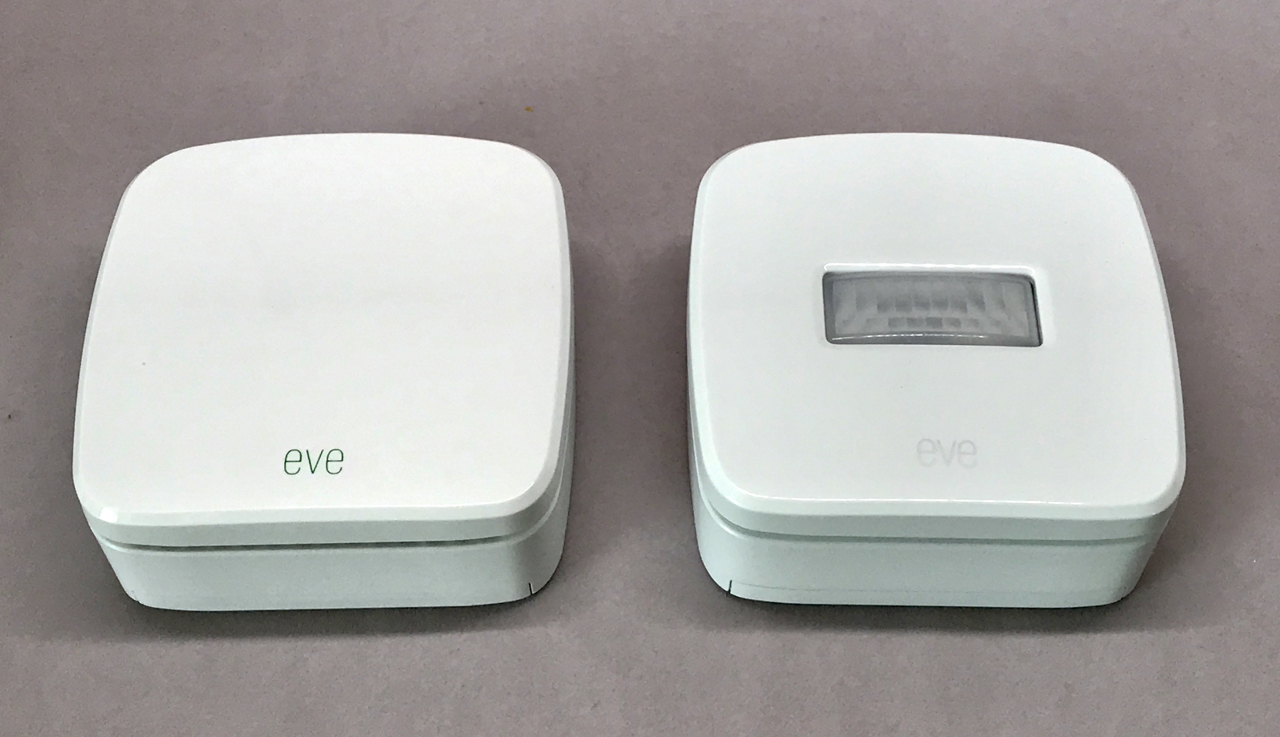
Elgato Eve Sensor device and Elgato Eve Motion (right)
In recent months some HomeKit-capable devices from Elgato have begun to appear in Bangkok stores. There are also others which may be controlled via Bluetooth only, while some non HomeKit devices are on sale too, but although I have looked carefully at some of these, I tend to steer clear of them. In the last few weeks some HomeKit CCTV and combined sensors (one from Nokia) have also appeared. The two I saw were priced just below 8,000 baht.
Last year I bought an Elgato Eve sensor device that reports temperature, humidity and air pressure. I access this information online frequently. While in the UK recently, where power is also 220v I turned the home internet off, but the data (almost 3 weeks) was stored within the device and synchronised to my iPhone when I came home. I bought that in the Apple Store, Milton keynes last year. This year, as I had to go to London one day, I visited the Regent Street store, which has undergone a considerable refit since the last time I was there and now has several features that I previously saw in San Francisco.
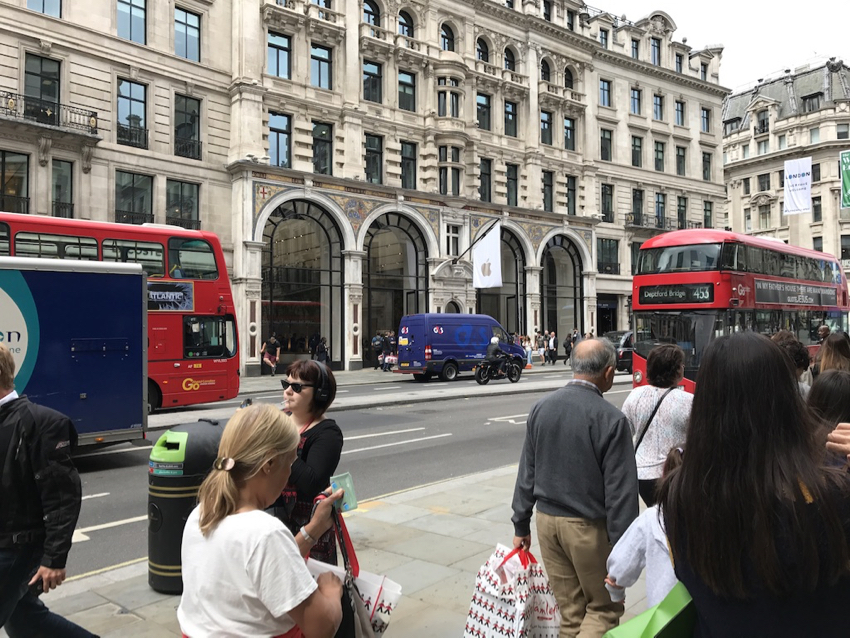
Apple Store - Regent Street, London
As well as displays of boxed devices, Apple had a useful demonstration that used large TV screens showing rooms with several devices. Attached iPhones and iPads were available so that it was possible to see how the Home app can be used to control such equipment. Not only were lights shown, but a fan (not available in the UK I was told), window blinds and other items. I had come in for a Philipps Hue starter kit, but I did not stop the young man (from Spain) showing me how it all worked. He commented that, despite the possibilities, not many had taken this up. It needs to reach some type of critical mass.
The starter kit with the white bulbs (£59.95 - 2586 baht) was much cheaper than the one with color bulbs, but I did add in a separate colour bulb (£49.95 - 2155 baht) so that I could try this once I returned to Bangkok. In the box is the Bridge device, which connects to the internet and 2 bulbs. These link to the Bridge via ZigBee Light Link. Up to 50 lamps can be connected to one bridge
When I unboxed the starter kit, I immediately saw limitations with the number of power outlets available in the condo. As the essential Bridge device is connected to the home network via Ethernet cable (LAN) that also restricted the locations available. I ended up with the Hue device sitting on top of the Airport router and connected to that by cable (in the Hue box). I put another lamp (with the larger bulb socket) and an additional power strip connector on the shopping list. As my ceiling lights are too high to reach safely without steps, I just used a single bulb initially, swapping it with the color bulb to try that out.
Once I had the hardware connected, I used an iPad to access the Hue pages online where I set up an account and read information on what to do. It will work without the Hue app, but once I had set the first bulb up on the iPad, I downloaded the most recent Hue Lifestyle app and used that. To link the Bridge with the device, I pressed the large button on the top of the Bridge and granted permission for the pairing. As I added devices, the button had to be pressed for each, so the iOS device needs to be within a few metres of the Bridge which must also be physically accessible.
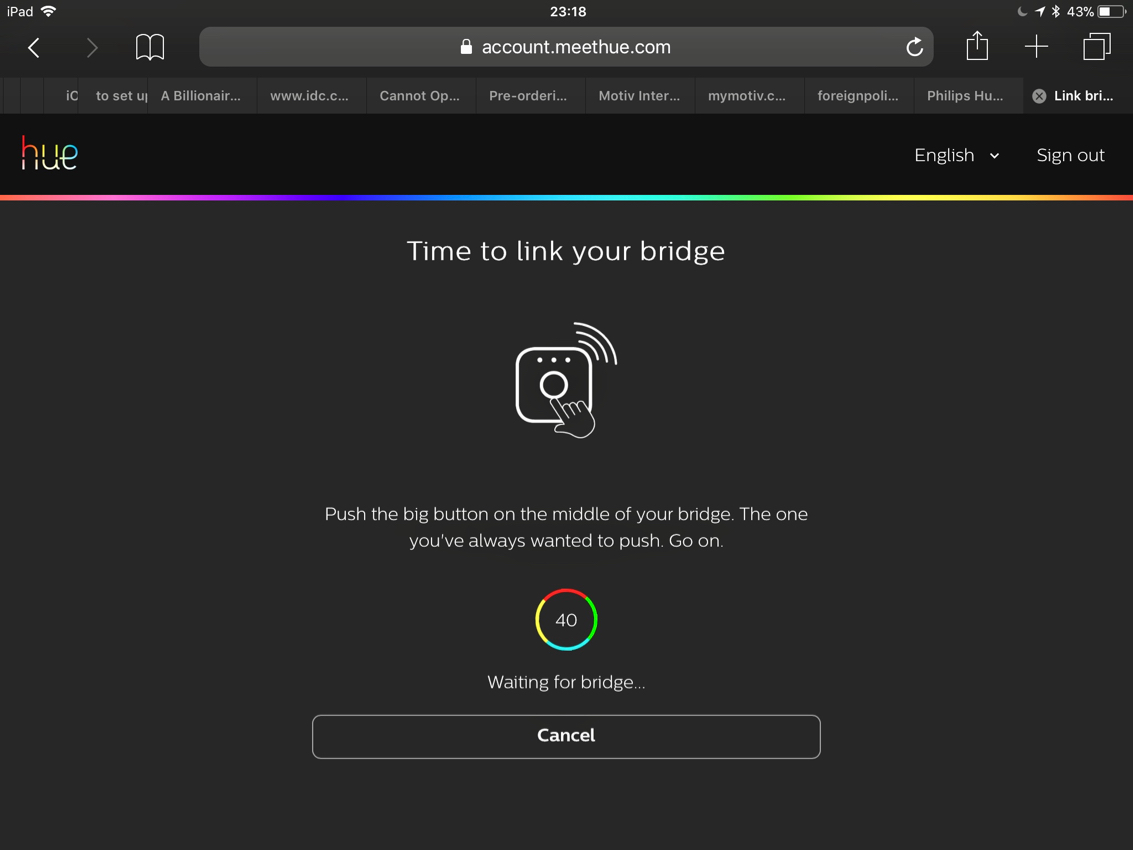
Setting up an account on the Philips Hue online information pages
On the internet access, once the bulb was shown as working, I pressed Off and it was extinguished. As I was making changes, it was necessary to update the system once or twice, including when I changed the white bulb for the coloured one. As I added iOS devices and began to experiment with Hue Lifestyle and the Apple Home app, it showed me that there is a wide range of options for adjustment and automation at my fingertips.
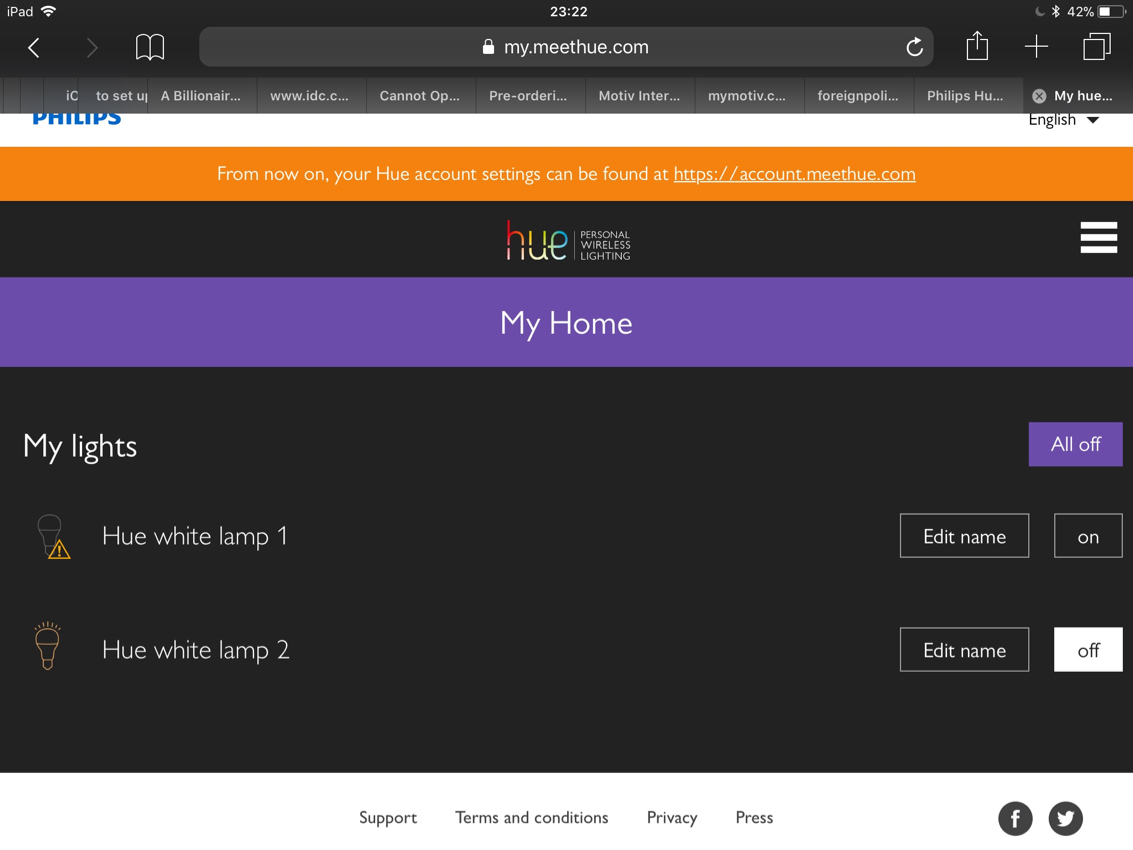
Home settings on Philips Hue online pages
During this early tryout, I was also given the option to pair with HomeKit and Siri. This needed the code on the box (and the back of the Bridge), in the same way as with the Elgato devices I have. A photo window is used and the app recognises the numerical code (similar to how a QR code is activated).
I noticed that when I took the colour bulb out of the box, it was slightly smaller, but heavier than the white bulb. Once this was installed and the Hue system updated, I began to look more deeply into how I could make changes and one of the keys (it seems to me) is with a panel marked, Scenes.
The Scenes panel already showed three options: Bright, Dimmed and Nightlight. A + icon accessed a two-part image select process. I could either use one of the ten Philips-provided images or my own Camera Roll so that I could use the colors from one of my own photographs. An update, however, removed these Scenes and replaced the adjustments with a set of easy to adjust circle sliders, and recipes. The Home app was unchanged, The white bulbs may also be adjusted here. When I added a second lamp to use one of the white bulbs that was instantly added to the Home and Hue Lifestyle apps.
After trying the Hue Lifestyle app for a while, I switched to Home where all bulbs were shown, although only one had the On/Off option. By touching this, I was able to slide the panel adjuster up or down to change brightness. The same panel could be used to change colours, but the 6 options were not the same as for the Hue Lifestyle app. An Edit function did allow the current selection to have its colour and temperature changed on the fly.
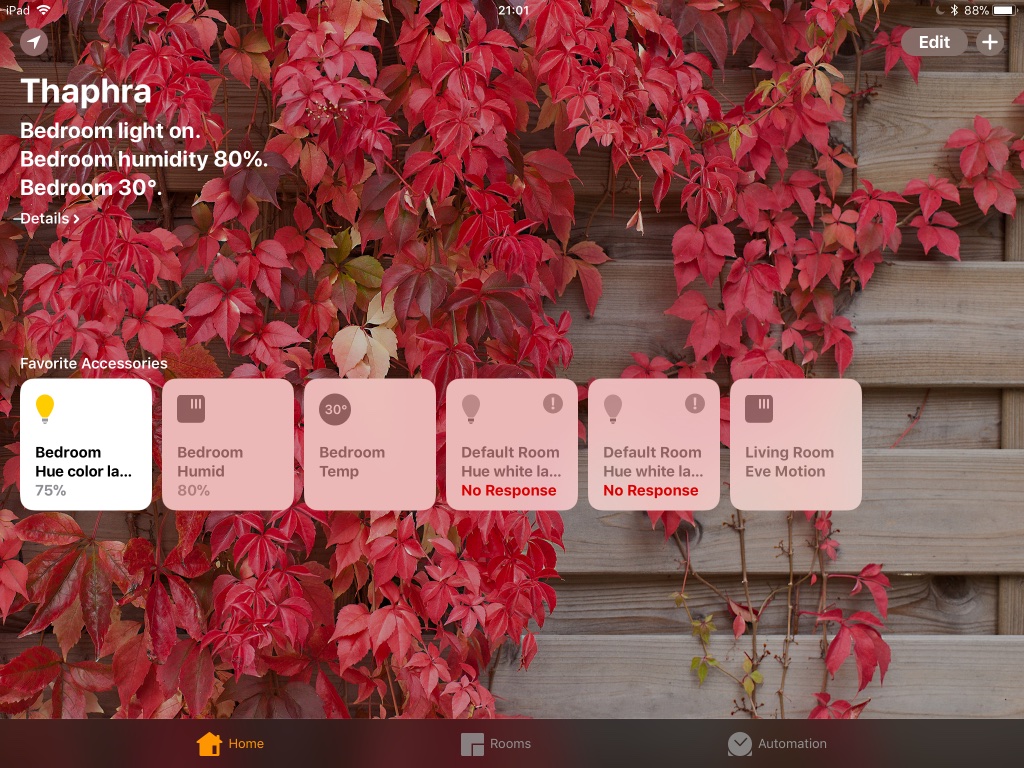
Home App on iPad - 2 white bulbs recognised but not installed
I did experiment with some automation as the Elgato Motion sensor has been sitting on top of the shelf for months with nothing to do. I added a scenario to turn the lights on when arriving, but later had to turn this off as the lights went on each time I went to the bathroom during the night. Some adjustment to time options, as well as a relocation might improve that. There is also the option of geo-location, so as the iPhone comes within range of my WiFi that could trigger an action.
Although I have not had much luck with Siri so far, things did look up when I used CarPlay in the Audi I rented in the UK. I made good use of Siri when setting up driving directions, either using a named location or the UK postcodes, although the Apple Maps directions system does have some idiosyncracies. I was helped here by the larger map display of the Audi just in front of me.
Siri responded quickly and correctly when I used the Philips Hue set up. The commands I used were simple and direct, such as on or off directions and changing the color. This is where the system is starting to become useful. As I add the other lights and (perhaps) more devices, it will be possible to make the things around me operate - using time, locations, motion - without the need to physically handle switches or connectors.
Hey Siri, dim the lights for a movie. . .
On a related note, this week a number of sites have reported on the announcements about the Sylvania Smart A19 Full Color LED Bulb, now available for pre-order. Juli Clover (MacRumors) reports that this "connects to a HomeKit setup over Bluetooth, so no hub or WiFi connection is necessary" and it does not need a hub or bridge. It will work when users are away from home if an Apple TV or iPad is used as a home hub. I will have to play with that too.
Graham K. Rogers teaches at the Faculty of Engineering, Mahidol University in Thailand. He wrote in the Bangkok Post, Database supplement on IT subjects. For the last seven years of Database he wrote a column on Apple and Macs. After 3 years writing a column in the Life supplement, he is now no longer associated with the Bangkok Post. He can be followed on Twitter (@extensions_th)
|







